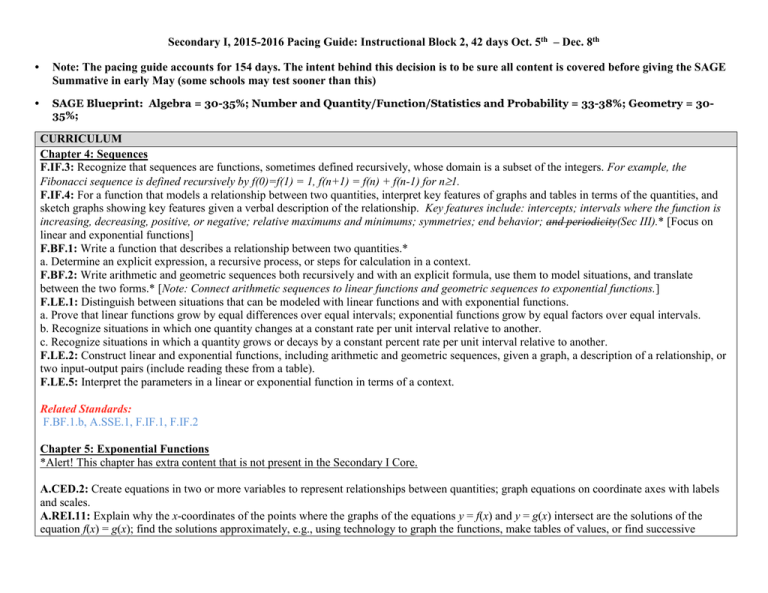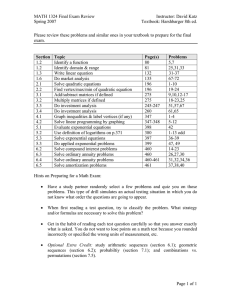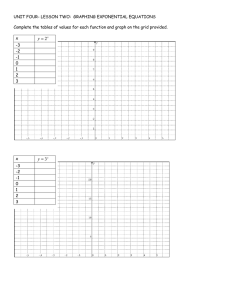Secondary I: Block 2 Exponential Functions, Sequences, Systems
advertisement

Secondary I, 2015-2016 Pacing Guide: Instructional Block 2, 42 days Oct. 5th – Dec. 8th • Note: The pacing guide accounts for 154 days. The intent behind this decision is to be sure all content is covered before giving the SAGE Summative in early May (some schools may test sooner than this) • SAGE Blueprint: Algebra = 30-35%; Number and Quantity/Function/Statistics and Probability = 33-38%; Geometry = 3035%; CURRICULUM Chapter 4: Sequences F.IF.3: Recognize that sequences are functions, sometimes defined recursively, whose domain is a subset of the integers. For example, the Fibonacci sequence is defined recursively by f(0)=f(1) = 1, f(n+1) = f(n) + f(n-1) for n1. F.IF.4: For a function that models a relationship between two quantities, interpret key features of graphs and tables in terms of the quantities, and sketch graphs showing key features given a verbal description of the relationship. Key features include: intercepts; intervals where the function is increasing, decreasing, positive, or negative; relative maximums and minimums; symmetries; end behavior; and periodicity(Sec III).* [Focus on linear and exponential functions] F.BF.1: Write a function that describes a relationship between two quantities.* a. Determine an explicit expression, a recursive process, or steps for calculation in a context. F.BF.2: Write arithmetic and geometric sequences both recursively and with an explicit formula, use them to model situations, and translate between the two forms.* [Note: Connect arithmetic sequences to linear functions and geometric sequences to exponential functions.] F.LE.1: Distinguish between situations that can be modeled with linear functions and with exponential functions. a. Prove that linear functions grow by equal differences over equal intervals; exponential functions grow by equal factors over equal intervals. b. Recognize situations in which one quantity changes at a constant rate per unit interval relative to another. c. Recognize situations in which a quantity grows or decays by a constant percent rate per unit interval relative to another. F.LE.2: Construct linear and exponential functions, including arithmetic and geometric sequences, given a graph, a description of a relationship, or two input-output pairs (include reading these from a table). F.LE.5: Interpret the parameters in a linear or exponential function in terms of a context. Related Standards: F.BF.1.b, A.SSE.1, F.IF.1, F.IF.2 Chapter 5: Exponential Functions *Alert! This chapter has extra content that is not present in the Secondary I Core. A.CED.2: Create equations in two or more variables to represent relationships between quantities; graph equations on coordinate axes with labels and scales. A.REI.11: Explain why the x-coordinates of the points where the graphs of the equations y = f(x) and y = g(x) intersect are the solutions of the equation f(x) = g(x); find the solutions approximately, e.g., using technology to graph the functions, make tables of values, or find successive approximations. Include cases where f(x) and/or g(x) are linear, polynomial, rational, absolute value, exponential, and logarithmic functions (Sec II and Sec III).* F.IF.3: Recognize that sequences are functions, sometimes defined recursively, whose domain is a subset of the integers. For example, the Fibonacci sequence is defined recursively by f(0)=f(1) = 1, f(n+1) = f(n) + f(n-1) for n1. F.IF.4: For a function that models a relationship between two quantities, interpret key features of graphs and tables in terms of the quantities, and sketch graphs showing key features given a verbal description of the relationship. Key features include: intercepts; intervals where the function is increasing, decreasing, positive, or negative; relative maximums and minimums; symmetries; end behavior; and periodicity (Sec III).* [Focus on linear and exponential functions] F.IF.6: Calculate and interpret the average rate of change of a function (presented symbolically or as a table) over a specified interval. Estimate the rate of change from a graph.* F.IF.7: Graph functions expressed symbolically and show key features of the graph, by hand in simple cases and using technology for more complicated cases.* e. Graph exponential and logarithmic functions(Sec III), showing intercepts and end behavior, and trigonometric functions, showing period, midline, and amplitude (Sec III). F.IF.9: Compare properties of two functions each represented in a different way (algebraically, graphically, numerically in tables, or by verbal descriptions). [For example, compare the growth of two linear functions, or two exponential functions such as y = 3n and 𝑦 = 100 ∙ 2𝑛 .] F.BF.1: Write a function that describes a relationship between two quantities.* a. Determine an explicit expression, a recursive process, or steps for calculation in a context. F.BF.2: Write arithmetic and geometric sequences both recursively and with an explicit formula, use them to model situations, and translate between the two forms.* [Note: Connect arithmetic sequences to linear functions and geometric sequences to exponential functions.] F.BF.3: Identify the effect on the graph of replacing f(x) by f(x) + k, kf(x), f(kx), and f(x + k) for specific values of k (both positive and negative); find the value of k given the graphs. Experiment with cases and illustrate an explanation of the effects on the graph using technology. Include recognizing even and odd functions from their graphs and algebraic expressions for them. F.LE.1: Distinguish between situations that can be modeled with linear functions and with exponential functions. a. Prove that linear functions grow by equal differences over equal intervals; exponential functions grow by equal factors over equal intervals. b. Recognize situations in which one quantity changes at a constant rate per unit interval relative to another. c. Recognize situations in which a quantity grows or decays by a constant percent rate per unit interval relative to another. F.LE.2: Construct linear and exponential functions, including arithmetic and geometric sequences, given a graph, a description of a relationship, or two input-output pairs (include reading these from a table). F.LE.3: Observe using graphs and tables that a quantity increasing exponentially eventually exceeds a quantity increasing linearly, quadratically, or (more generally) as a polynomial function (Sec II). F.LE.5: Interpret the parameters in a linear or exponential function in terms of a context. Related Standards: A.SSE.1, A.CED.1, A.REI.10, N.Q.2, A.REI.3, Sec II - *N.RN.1, *N.RN.2 Chapter 6: Systems of Equations A.REI.5 Prove that, given a system of two equations in two variables, replacing one equation by the sum of that equation and a multiple of the other produces a system with the same solutions. A.REI.6: Solve systems of linear equations exactly and approximately (e.g., with graphs), focusing on pairs of linear equations in two variables. A.REI.11: Explain why the x-coordinates of the points where the graphs of the equations y = f(x) and y = g(x) intersect are the solutions of the equation f(x) = g(x); find the solutions approximately, e.g., using technology to graph the functions, make tables of values, or find successive approximations. Include cases where f(x) and/or g(x) are linear, polynomial, rational, absolute value, exponential, and logarithmic functions (Sec II & Sec III).* F.IF.9: Compare properties of two functions each represented in a different way (algebraically, graphically, numerically in tables, or by verbal descriptions). [For example, compare the growth of two linear functions, or two exponential functions such as y = 3n and 𝑦 = 100 ∙ 2𝑛 .] Related Standards: A.REI.10, A.CED.2 Chapter 7: Systems of Inequalities A.CED.3: Represent constraints by equations or inequalities, and by systems of equations and/or inequalities, and interpret solutions as viable or non-viable options in a modeling context. For example, represent inequalities describing nutritional and cost constraints on combinations of different foods. A.REI.12: Graph the solutions to a linear inequality in two variables as a half-plane (excluding the boundary in the case of a strict inequality), and graph the solution set to a set to a system of linear inequalities in two variables as the intersection of the corresponding half-planes. Vocabulary: Models: Strategies: INSTRUCTION Carnegie Textbook Chapter 4: Sequences Chapter 5: Exponential Functions Chapter 6: Systems of Equations Chapter 7: Systems of Inequalities Student’s Skills Practice ASSESSMENT Before Instruction: Pre-Test During Instruction: Check for Students’ Understanding After Instruction: Post Test, End of Chapter Test, Standardized Test Practice




